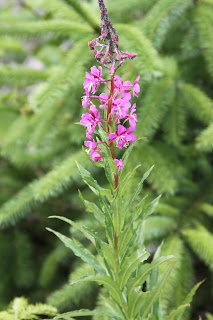Prince George, British Columbia High 59 Low 46
On our last day in Prince Rupert we went to the remains of
the North Pacific Cannery. It is the last remaining; fairly intact cannery of
what once was a lot of small salmon canneries in this part of the country.
 |
| Sign for one of many canneries along the Skeena River. |
 |
| The road to the cannery reminded us of the roads in Alaska, very rough. |
 |
| Where we stopped for the night on Tuesday. |
 |
| Penny waiting patiently for us to get in the truck. |
Our first stop was to see where the nets were hung to dry,
treated to make them last longer, and to do any repairs that were necessary.
We found out that the housing for the workers left a lot to
be desired. Our guide, who was a grand-daughter of one of the first nation
workers at the cannery, showed us one of the living quarters of her people. It
was a small room, approximately 15 X 15 that housed 12 people. At the time the
cannery was going there were many of these houses.
 |
| First Nation housing. |
 |
| The one on the left closest to us was the managers house. |
There also was separate housing for the Chinese and European
workers. The Managers house, which he said had to be the biggest, was also very
close to the large smelly tanks, and our guide told us the smell was horrible.
It didn’t look very big but was a lot larger than the other housing.
 |
| Our guide, Cindy's Mom ,her sister Linda, and myself. |
We went upstairs to the canning machines. It seems that in
the early 1900’s they used lots of lead for sealing the cans, then in about
1920 a lid was invented with a gasket instead of having to be soldered.
Cleanliness in the early days was not of major importance. They figured the
cooking process would kill any bad things in the salmon.
The slowest part of the process was the cutting up the
salmon and in 1920 a machine was invented that could do the work of many of the
Chinese workers, hence the name of the machine.
The salmon was packaged under many different labels, and we
were shown a lot of the different ones.
We got to see the offices and company store. We also got to see script that was given to the workers to use in the store. Our guide told us that many of the workers left at the end of the season owing the store, which reminded me of the song Sixteen Tons.
 |
| Part of the office. |
 |
| One of the old buildings still under reconstruction. |
 |
| This was used by the watchman in the off season, which he had to turn daily so the owners could check on him at the end of the off year. There was a key at each check point which he had to turn. |
 |
| Part of the script money used by the workers. |
The plant closed in 1969 and was opened for one season in
1971, when the newer cannery in Prince Rupert burned down. In 1985 it was in
danger of being demolished, but through the efforts of one woman, it was saved
as a historic landmark.
It was an interesting visit.
 |
| This Fireweed also reminded us of Alaska. |
Tomorrow we are heading back to Hinton, Alberta. Cindy’s Mom
and sister left this morning and are headed south, while we will head east.
Thanks for visiting.
















No comments:
Post a Comment